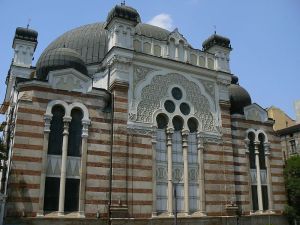A small country (approximately 7,5 million people) situated in the South of Europe, part of the Balkan Peninsula and one of the newest members of the European Union, Bulgaria has an interesting culture and a fascinating past to which religious diversity has contributed a lot over the centuries.
The country is considered by tradition a Christian one, ever since 865 when the Constantinopole Christianity was adopted. The majority of the population therefore belongs to the Bulgarian Orthodx Church (around 82%). This church is the oldest among the Slavic Orthodox churches and has had a major cultural influence on the other Eastern churches also because of the invention of the Chirilic alphabet in Bulgaria, that was quickly adopted by the surrounding Slavic nations.
However, Bulgaria has another important religious community, that of the Moslims which comprises almost one million people concentrated mainly in the Rhodopes Mountains and in the northern part of the country.
These are descendants of the Turks, which arrived in Bulgaria during the Ottoman conquest of the Balkans in the 14th-15th century. The Pomaks (Bulgarian nationals that converted to Islam under the Ottoman rule of Bulgaria) are also representatives of the Islam Bulgarian community, which, at the start of the 20th century were the subject of state-supported assimilation. This meant that they had to change their Turkish-Arabic names to Bulgarian ones and reconvert to Orthodoxy in an attemt of the state to reassert their ancestral Bulgarian origins.
The Bulgarian Jews, although accounting for a very small religious community in the present, have been a constant presence in Bulgaria ever since the second century BC, exerting their cultural influence over the centuries. Although a law restricting their legal rights was passed in 1941 (Law for the Protection of the Nation), the Bulgarian Jews were not deported to concentration camps but could continue to live safely in the country. After the war and the establishment of the Communist government most of them left for Israel, leaving a mere thousand people today.
Over these religious groups, which place Bulgaria somewhere at the crossroads between Occident and Orient, eighteen young people coming from twelve European countries will discuss at the Eustory Youth Academy in Bulgaria. They will first meet in Sofia, a city known for its so-called Triangle of Religious Tolerance, where the Orthodox church, the Mosque and the Synangogue are placed in the city centre within metres of each other, and then travel to Plovdiv, the oldest city in Europe and sixth oldest settlement in the world, continously inhabited since 3,000 BC, where the paths going from Europe to Asia and Africa used to meet in ancient times.
During the seminar the students will publish their work results in the virtual gallery of a museum and of course will keep you updated with their progress on this blog. So be sure to be reading our interesting posts starting next week! We also hope that you know more about religious diversity in Bulgaria after reading this post.





Martin
This is going to be fantastic! Can’t wait!
vreausapotsapotsavreau
There will be a final comparation between Berlin, Scuol and Sofia? I’ll bet for Berlin